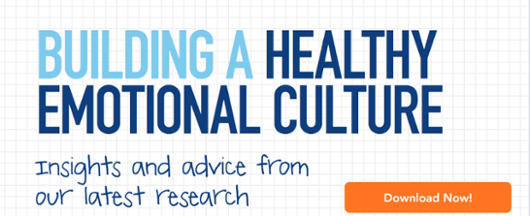How to Deal with Negative Emotions at Work: Next Steps for Managers
 With aggressive year-end goals and fast-approaching deadlines, negative emotions can surface and wreak havoc on employees, teams, and organizations.
With aggressive year-end goals and fast-approaching deadlines, negative emotions can surface and wreak havoc on employees, teams, and organizations.
If your managers do not know how to deal with negative emotions at work—they will increase stress levels, create barriers between employees, and may impact other areas of the business; including productivity, innovation, and customer service.
Negative Emotions
The danger of negative emotions lies in their ability to multiply and spread like a virus. It’s important for your organization, and your managers, to understand the most common types of emotions in the workplace, how to address them in a supportive manner, and how to proactively minimize their frequency.
Here are the most common negative emotions identified by research and how you can take action to combat the negativity:
Frustration
There are a lot of factors that can contribute to frustration, including lack of progress, miscommunication, and boredom. And frustration can present itself in a variety of ways.
Employees who are frustrated might also feel annoyed, miserable, and even unhappy. When employees get frustrated, it can take a long time for them to think differently about their role, their team, and the organization.
Here’s what employees said about frustration:
- “I was upset and frustrated that the manager on call refused to come in and help in an extremely urgent time.”
- “I get most frustrated when people don’t share information with me that I need to do my job correctly.”
- “I felt frustrated that I wasn’t getting anywhere in my career.”
How to decrease frustration at work
Feeling stuck can lead to frustration. Be sure to foster ongoing career and development conversations to help employees feel forward momentum at work. Make sure employees have the tools and resources they need to do their jobs effectively. Strive for open, timely, and transparent communication.
Stress
Stress is one of common emotions employees experience at work. A society of instant gratification, driven by technological advances, has inspired a workplace consisting of long, strenuous schedules and competitive outcomes.
The CDC defines job stress as, “the harmful physical and emotional responses that occur when the requirements of the job do not match the capabilities, resources, or needs of the work.” Without clear expectations and achievable goals, stress is bound to infect your workforce.
Here’s what employees said about stress:
- “My manager was not communicating with me, cutting my projects and making me feel like I was not a valuable employee. I was stressed, miserable, and unhappy.”
- “I felt stressed and overwhelmed due to the amount of work that needed to be done in such little time.”
- “I felt a lot of anxiety and stress at my last job as a project manager. It was really overwhelming with a ton of work to do, and my client wasn’t helpful or understanding.”
How to decrease stress at work
Too much work is not a good thing. Make a serious attempt to keep employee workloads manageable. Instill solid and consistent manager-to-employee communication to make a big difference in stress levels. Employees who work with customers are susceptible to increased stress. Try to give them the tools and strategies they need to cope with stressful customer situations and remind them that you care about their wellbeing just as much as you care about your bottom line.
Our research also found that managers feel stressed and frustrated more often than individual contributors but feel anxious less often. Increased stress is expected with the added responsibilities and demands of managers, but organizations should try to find ways to support managers through that stress. The difference in anxiety levels between employees and managers might mean that managers need to communicate better or provide better tools and resources for employees to get work done.
Anxiety
Rooted in insecurity, anxiety can be a dangerous emotion for your employees at work. When employees are anxious, they often feel unsupported, misunderstood, or undervalued. Further, anxiety breeds other emotions like worry, gloom, and discomfort which are keeping your employees from achieving their personal and professional goals.
Here’s what employees said about anxiety:
- “I felt anxious when I was instructed to do something that I did not know how to do. I was too anxious to ask for step-by-step directions.”
- “My anxiety stemmed from my company letting me know they were no longer profitable. This made me fearful for my job and my future.”
- “A client misunderstood what I was saying and thought I was purposely being rude to her. I was very worried and anxious about the situation, and how my boss would react.”
How to decrease anxiety at work
Anxiety often stems from the fear of the unknown. Keep employees in the loop with frequent, timely, and transparent communication. Let employees know it’s okay to ask for help, and ensure they know how to access all the resources available to them. Institute an open-door policy so employees can voice concerns and ask for advice when sticky situations arise.
Moral Emotions
Basic emotions such as happiness and sadness are straightforward and easy to understand. But many of the most important emotions that affect employees are much more complex. Enter moral emotions. Morals are the principles that differentiate between good and bad behavior, and they vary from person to person. Individuals have a unique moral compass that provide immediate punishment or rewards for thoughts and behaviors.
Emotions that are influenced by our morals are called moral emotions. They include emotions like guilt, regret, and shame — and they carry much more weight than our primary emotions. When left unchecked, moral emotions can have a serious impact on the workplace. Organizations must find the right balance of supporting and preventing these emotions at work.
Here are the most common moral emotions identified by research and how you can take action to reduce these feelings at work.
Humiliation
When we think about humiliation, we probably revert back to our earliest childhood memory of stepping in gum or falling down in front of a crush. But humiliation in the workplace has much larger implications to overall employee success.
Here's what employees said about humiliation:
- “When my supervisor reprimanded me on the sales floor in front of customers and a coworker, I felt so humiliated. It was uncalled for and he could have taken me in the back.”
- “I feel especially frustrated and betrayed when people escalate issues to my supervisor without bringing them to my attention first. When people do this, it feels like I am being attacked personally, and their intent is to humiliate me rather than solve the problem at hand.”
- “A co-worker showed my work to our entire team without telling me first and she proceeded to critique it in front of everyone. I felt humiliated and defensive.”
How to avoid humiliation at work
The best way to reduce humiliation among your team is to foster an environment where employees are comfortable with, and now how, to give honest and professional feedback. By building a feedback culture, will help your employees begin to resolve their own conflicts. Set the example by addressing mistakes and concerns in a private, one-on-one setting and providing feedback in a consistent and continuous manner.
Disgust
Disgust is a moral emotion that can foster a lot of other deeply rooted feelings and fears. When employees feel disgust, they often feel helpless and not sure where to go next. Empowering your employees with the right resources and support from managers can help generate new motivation and reduce the bad taste in their mouth about your organization.
Here’s what employees said about disgust:
- “When my manager wrongly criticized my work. I was disgusted and felt very under-appreciated.”
- “Metrics there were beyond our control quite often. I felt helpless and disgusted and anxious and just wanted to leave and not come back.”
- “My employment was threatened due to missing work from an injury after a car accident. I was extremely disgusted and unmotivated to work there.”
How to avoid disgust at work
Knowledge is power. Ensure everyone at your organization is trained to give and receive effective feedback and let employees have a voice in individual and team goals. There’s nothing more discouraging than trying and failing to reach an impossible goal. Demonstrate care and concern for your employees and their personal lives, especially in times of crisis, and help them reach organizational goals as a team.
Resentment
Potentially the most powerful of all, resentment often shows up as envy, guilt, jealousy, shame, and anger. Employees who are misrepresented or undervalued often feel resentment towards peers, managers, and the organization as a whole.
What employees said about resentment:- "We had one client make a minor complaint and my immediate manager acted like it was a huge travesty and we had done something terrible. It made me feel frustrated, resentful, and disregarded."
- "Prior employment was too stressful, work overload and pressure caused anger and resentment toward company culture and immediate managers."
- "I was overlooked for some recognition while my two teammates were rewarded. I felt ignored, resentful, and disgruntled."
How to avoid resentment at work
When a problem arises, don’t place blame on employees. Try to attack the problem, rather than the person. Make sure employees have a reasonable workload, adequate resources, and are recognized when it’s deserved. Even employees who love their jobs can suffer from burnout.
Being mindful of the variety of negative emotions that are likely to surface within your organization is a powerful way of showing your employees that you care about their personal feelings and want to make a difference. While negative emotions that go unnoticed can spiral into toxic work environments, you can reduce and often reverse these emotions to become positive ones.
Learn more about Emotions in the Workplace with our latest research on how employees feel at work and why it matters.







